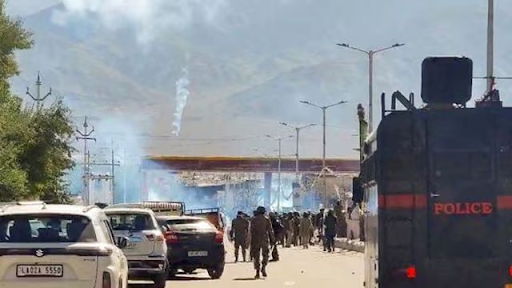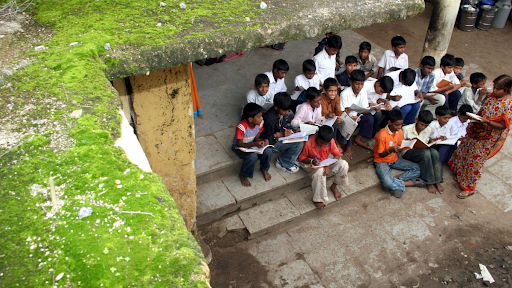Description

Disclaimer: Copyright infringement not intended.
Context:
- The Maharashtra government tabled the “Maharashtra Special Public Security Bill, 2024 in the Assembly” to check urban Naxalism
Maharashtra Special Public Security Bill, 2024
|
About
|
- Aims to prevent unlawful activities of individuals, organisations, and 48 banned frontal organisations.
- Modelled after the Public Security Acts of Chhattisgarh, Telangana, Andhra Pradesh, and Odisha.
|
|
Definition of Unlawful Activity
|
- Actions posing danger to public order, peace, tranquillity.
- Interference with law enforcement or institutions.
|
|
Unlawful Organization
|
- Includes any group promoting unlawful activities.
- Abetting, aiding, or encouraging unlawful activities is punishable.
|
|
Penalties
|
- Members participating in unlawful organisation activities face up to 3 years' imprisonment and fines up to ₹3 lakh.
- Managers or promoters of such organisations face similar penalties.
- Offenders committing or abetting unlawful activities may face up to 7 years' imprisonment and fines up to ₹5 lakh.
|
|
Government Actions and Powers
|
- District Magistrates or Commissioners of Police can seize properties used for unlawful activities once an organisation is declared unlawful.
- Powers to forfeit funds and assets of unlawful organisations.
|
|
Enforcement Provisions
|
- Officers are empowered to enter premises, examine financial records, and seize assets used for unlawful activities.
|
|
Legal Proceedings
|
- Offences under the Bill are cognizable and non-bailable.
- Investigations to be conducted by police officers of at least Sub Inspector rank.
|
|
Advisory Board
|
- Comprises three members, including former High Court judges.
- Powers include summoning witnesses, examining evidence, and issuing commissions for witness examination
|
Urban Naxals:
- The term 'Urban Naxals' lacks a precise definition but it is said to have been coined around 2018 to describe anti-establishment protesters and dissenters, particularly linked to the aftermath of the Elgaar Parishad case in Maharashtra.
- Originated amidst crackdowns on left-wingers and liberals involved in the Bhima Koregaon violence investigations.
- It also gained prominence through Vivek Agnihotri's book and essays, "Urban Naxals: The Making of Buddha in a Traffic Jam".
- This term loosely describes activists, supporters, and ideologues who align with Naxalism, contrasting with active Naxals who operate in remote, Maoist-dominated regions.

|
Elgaar Parishad Case:
- The Elgar Parishad case revolves around an event held in Pune, India, in December 2017, organized by activists to commemorate the 200th anniversary of the Bhima Koregaon battle.
- Subsequently, the Pune police claimed that provocative speeches made at the event led to violence the following day, accusing several activists and intellectuals of having links to Maoists and inciting violence.
- This case has sparked significant controversy, with allegations of misuse of state power against dissent and criticism of the government.
- Investigation uncovered materials indicating a broader underground network of Naxalite groups.
|
Strategy of Urban Naxals
- Maoist strategy historically involves seeking urban leadership, organising support, and building alliances, as detailed in their 2004 document "Urban Perspective".
- This strategy underscores the importance of urban areas in providing personnel, resources, and infrastructure support for their operations
Naxalism and Urban Naxals:
|
Context
|
Naxalism
|
Urban Naxals
|
|
Origin
|
Emerged as a Maoist-inspired armed rebellion in the late 1960s in Naxalbari village in West Bengal.
|
Coined term in modern discourse to describe supporters within urban areas and its origin is disputed.
|
|
Nature
|
Armed insurgency against the state.
|
Non-violent support or sympathy for Naxal ideology.
|
|
Activities
|
Engage in guerrilla warfare, attacks on state targets.
|
Intellectual support, advocacy, propaganda.
|
|
Location
|
Operate primarily in rural areas, forests.
|
Operate in urban centers, universities, intellectual circles.
|
|
Objective
|
Overthrow government, establish communist rule.
|
Support Naxalite ideology, criticize state policies.
|
|
Legal Status
|
Considered illegal, banned under law.
|
May be Legal or illegal activities under freedom of speech, subject to scrutiny.
|
Strategy to tackle Urban Naxalism:
- Legal Scrutiny and Due Process: Ensure that investigations into alleged Urban Naxals adhere strictly to legal procedures, respecting civil liberties and due process. This includes thorough investigations based on credible evidence rather than mere suspicion or ideological differences. The National Investigation Agency’s staff should be particularly trained in this direction.
- Counter-Narratives and Awareness: Develop and promote counter-narratives that expel extremist ideologies and educate the public about the risks and consequences of supporting or sympathising with Naxalism. This could involve educational campaigns, seminars, and media engagements. For instance, the Chhattisgarh government launched a comprehensive campaign involving seminars, workshops, and media engagements to counter Naxal ideologies.
- Monitoring and Surveillance: Enhance intelligence gathering and surveillance capabilities to monitor activities and networks associated with Urban Naxals. This should be done within the framework of privacy laws and judicial oversight to prevent misuse.
- Community Engagement: Enhance community engagement initiatives aimed at addressing socio-economic grievances that may contribute to sympathy towards Naxal ideology. Building trust and providing alternative avenues for addressing grievances can reduce support for extremist ideologies.
- Legal Reforms and Policy Interventions: Review and possibly reform laws related to sedition, terrorism, and freedom of speech to ensure they strike an appropriate balance between national security and civil liberties. Section 43B of the UAPA providing for “Procedure of arrest, seizure, etc. must be implemented in letter and spirit to ensure its misuse.
Conclusion:
- Addressing urban Naxalism necessitates comprehensive strategies involving law enforcement, socio-economic development, and dialogue to mitigate radicalization and promote inclusive growth and stability in society.
For detailed study on Naxalism in India refer:
https://iasgyan.in/ig-uploads/pdf/8175710.pdf
Source
https://www.ndtv.com/india-news/bill-on-urban-naxalism-tabled-in-maharashtra-assembly-6082623
https://www.indiatoday.in/india-today-insight/story/who-is-an-urban-naxal-1911450-2022-02-10
|
PRACTICE QUESTION
Q) Urban naxalism is perceived as a challenge to internal security by many scholars but the term lacks legal definition and there is challenge in addressing the issue. Critically Analyse. (250 words)
|











